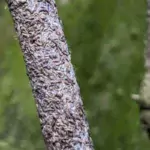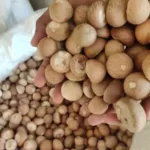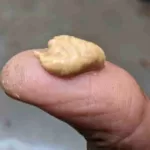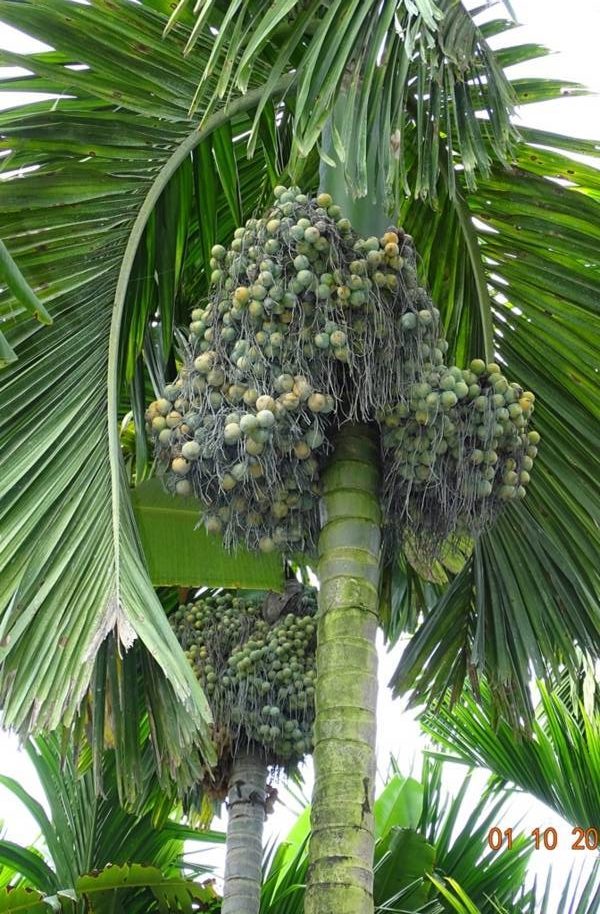Trichoderma is a genus of asexual fungi found in the soils of all climatic zones. Out of the existing fungal biocontrol agents, Trichoderma spp. are studied for their effects on reducing plant diseases. These fungi are opportunistic, avirulent plant symbionts, and function as parasites and antagonists of many disease causing fungi and nematodes thus protecting plants from disease.
Trichoderma strains are among the most studied fungal biocontrol agents and are successfully used as biopesticides and biofertilizers in greenhouse and field for plant production. Trichoderma are also a major source of enzymes that has industrial applications. The ability of Trichoderma to control plant diseases and to promote plant growth and development has enabled development of different formulations using a variety of Trichoderma strains and are available commercially for crop production worldwide.
Species of Trichoderma are conspicuous for their ubiquitous distribution, dominance over other soil fungal communities. Their nutritional requirement is minimal and has the mechanism to utilize the cell wall components such as cellulose and chitin as carbon source, produce abundant propagules, which include mycelium, conidia, and quiescent resting spores, which grow upon availability of nutritional source. They are adapted to survive in varied habitats such as decaying wood, cotton fabrics and aerial and subterranean plant parts. In order to survive in such varied habitats they are endowed with superior competitive nature and possess an arsenal of cellulolytic enzymes. Their ability to produce various volatile and non-volatile metabolites makes them efficient antagonists for several pathogens of agricultural crop plants. The high degree of ecological adaptability, the ability to grow on inexpensive substrates makes Trichoderma amenable for mass multiplication and manipulation for various formulations and delivery systems. Trichoderma harzianum as a group have adaptation to survive varying pH conditions and temperatures ranging from 25-35ºC. All these characters render Trichoderma species as successful biocontrol agents.
Root colonization
The understanding of root colonization is important for various applications such as biofertilization, biocontrol, biostimulation and bioremediation. Along root colonizing bacteria Pseudomonas has been rated at the top. Root colonization is studied using several techniques. The important being confocal laser scanning microscopy, green fluorescent pigment (gfp) in gnotobiotic systems. Fluorescent pseudomonads being efficient colonizers have been studied intensively. Competitions among fluorescent pseudomonads also occur as revealed by studies involving mutants
Mechanisms of action of Trichoderma
The strains of Trichoderma used as biocontrol agents show different mechanisms of action in their antagonistic interactions with fungal pathogens. These include antibiosis, through the production of a variety of compounds with antibiotic activity that prevent other microbes, mycoparasitism or hyperparasitismin which Trichoderma kills the disease causing organism for its own nutrition. The second method is by competing for nutrients and space with other organisms. The third mechanism being the ability to produce cell wall dissolving enzyme activity by which the disease causing fungal cell walls are dissolved and Trichoderma use the cell contents as nutrition. The fourth being induction of systemic resistance to pathogens in plants. Of these, antibiotic production is considered to play an important role during biocontrol events, although the interactions in soil and plants are not yet fully elucidated. Different volatile and nonvolatile secondary metabolites have been characterized from Trichoderma spp. by antibiotic assay-guided isolation and the production of antibiotic molecules by certain strains is often well correlated with their biocontrol ability.
Trichoderma as an endophyte
Microbes both fungi and bacteria also reside inside plant tissues without causing any apparent symptoms are called endophytes. The micro fungi that grow asymptomatically in healthy plant tissues for all or the most of their life cycle is termed fungal endophytes and have been reported in most plant species. Some of the antagonists of pathogen such as Trichoderma spp. also enter the host tissue and live as endophytes. A large number of bacteria are also adapted to reside inside plant tissues as endophytic bacteria. A majority of the bacteria reside in the rhizosphere and gain entry in to the tissues through natural openings. These organisms are also isolated, screened against plant pathogens and used as biocontrol agents. Among the root inhabiting organisms, fluorescent pseudomonads constitute a major successful colonizers followed by bacilli. Itwas Kloepper and Schroth (1978) who initially reported that certain root-colonizing bacteria could promote growth in greenhouse and field trials and named the bacteria plant growth-promoting rhizobacteria (PGPR). The enhanced growth is both by mobilizing nutrients and protecting against pathogens. For the plants, the first line of defense against soil borne pathogens is provided by the rhizosphere microorganisms. In order to retain this niche, these organisms have evolved mechanisms to actively colonize the roots and prevent other competitors including pathogens and trigger defense system of the host plant. The rhizosphere organisms that have higher rhizosphere competence have an edge over the native strains as demonstrated in case of fluorescent pseudomonads and also antagonistic Trichoderma.
Disease suppression by Trichoderma

Direct biocontrol effects of Trichoderma on soil borne plant pathogens is by hyperparasitism documented for various fungal pathogens, such as Rhizoctonia, Sclerotinia, Verticillium and Gaeumannomyces. Hyperparasitism by Trichoderma involves secretion of chitinases and cellulases, which release small molecules from the target pathogen and trigger chemotropism towards the latter. The contact is followed with coiling of hyphae around the hyphae of the pathogen, further enzymatic digestion of its cell wall, and penetration by Trichoderma. Antimicrobial secondary metabolites are also involved in antagonistic effects of fungi such as Trichoderma and Gliocladium. The concentration at which these compounds are toxic towards pathogenic bacteria, fungi and nematodes depends on the compound and the target.
Trichoderma–plant interaction
In addition to the beneficial effects that occur in direct interactions with plant disease agents, some Trichoderma species are also able to colonize root surfaces and cause substantial changes in plant metabolism. It is well documented that some strains promote plant growth, increase nutrient availability, improve crop production and enhance disease resistance. The physical interaction between Trichoderma and the plant was observed by electron microscopy to be limited to the first few cell layers of plant epidermis and root outer cortex. The hyphae of the BCA penetrate the root cortex but the colonization by Trichoderma is stopped, probably by the deposition of callose barriers by the surrounding plant tissues. It appears that this interaction evolves into a symbiotic rather than a parasitic relationship between the fungus and the plant, whereby the fungus occupies a nutritional niche and the plant is protected from disease. A very active, direct molecular cross-talk occurs between the fungus and the plant. Elicitors from Trichoderma activate the expression of genes involved in the plant defense response system, and promote the growth of the plant, root system and nutrient availability. This effect in turn augments the zone for colonization and the nutrients available for the biocontrol fungus, subsequently increasing the overall antagonism to plant pathogens.
Mechanism of growth promotion
In addition to the effectiveness of Trichoderma spp. in controlling plant pathogens, many studies have shown the direct benefits of these fungi on plant growth and production. They are; increased plant nutrition through solubilization and/or enhanced uptake of macro- and micronutrients and production of plant growth factors and inhibition of deleterious root microflora. These mechanisms are responsible for the ‘biofertilizer effect’ of Trichoderma. In the case of the solubilization of insoluble or sparingly soluble minerals, T. harzianum or its culture filtrates were reported to solubilize Fe2O3, MnO2, metallic Zn, and rock phosphorus in vitro through chelation and redox activity; acidification did not seem involved. solubilization of P from both tricalcium phosphate and rock phosphate by T. harzianum and T. viride is also reported. Although there has been little work devoted to the implication of plant growth factors in the Trichoderma plant growth promoting effect, recent work has demonstrated that cytokinin-like molecules, possibly kinetin, may be produced by Trichoderma. T. atroviride has been shown to produce and degrade indole acetic acid (IAA), the most common plant auxin and to possibly possess amino cyclopropane carboxylic acid (ACC) deaminase activity that would control ethylene production.
Trichoderma on plant parasitic nematodes
Nematodes are mostly present in rhizosphere than in the bulk soil. Trichoderma species are reported to inhibit or kill plant parasitic nematodes through multiple modes of action mainly through chitinolytic activity of the fungi on cellular structure of nematodes, which is rich in chitin.
Microbial nutrition mobilization
The soil micro organisms mobilize these plant nutrients and supply to the root zone. The root zone known as rhizosphere is the site of intense microbial activity. The root zone is also rich in nutrients such as carbohydrates, amino acids, cell wall components etc. exuded by the plants. The type of microbial community in the root zone depends upon the type of root exudates. The rhizosphere is often compared to the gastro intestinal tract of human beings which is very important for the digestion of food and absorption. The micro organisms in the gastro intestinal tract of humans maintain a delicate equilibrium between the useful beneficial organisms and the harmful ones. Similarly in the rhizosphere of plants both beneficial and harmful organisms exist. Most often the plant recruits its own microbes by modulating its secretions.
Soil borne diseases
Plants are subjected to attack by disease causing micro organisms (pathogens) belonging to fungi, nematodes, bacteria, viruses, and parasitic higher plants. Based on the plant part affected it is classified into aerial and soil borne diseases. The aerial diseases often get more importance as one can easily see the damaged portions. Economically the losses due to soil borne diseases are far more than aerial diseases. Prominent soil-borne pathogens include Phytophthora and Pythium among oomycetes, Fusarium, Sclerotium, Macrophomina, among fungi, root knot and burrowing nematodes among plant parasitic nematodes and Ralstonia among bacteria. They represent major sources of biotic stress in the rhizosphere and roots of plants. Managing soil borne pathogens is challenging as the pathogens have evolved sophisticated mechanisms to suit this niche, to tide over unfavourable conditions and swiftness in colonizing the host. The long incubation periods lead to delays in symptom expression and it is prolonged till considerable damage has been caused to the underground portions often rendering the management strategy ineffective. Soil borne pathogens such as Phytophthora species are also adapted to aerial infection and affect all parts of the plant as in black pepper. The interaction of microbes in the bulk soil and the rhizosphere vary considerably due to the rhizosphere effect. This aspect needs consideration while dealing with biological control of plant diseases. While generating efficacy data for biocontrol agents it is worthwhile to study the rhizosphere competence. The strains possessing rhizospehere competence has a better chance of survival against intense completion and perform better than the native strains.

Plant growth promoting rhizobacteria (PGPR)
Plant growth promoting rhizobacteria (PGPR) are the rhizosphere bacteria that can enhance plant growth by a wide variety of mechanisms like phosphate solubilization, siderophore production, biological nitrogen fixation, rhizosphere engineering, production of 1-Aminocyclopropane-1- carboxylate deaminase (ACC), quorum sensing (QS) signal interference and inhibition of biofilm formation, phytohormones production, exhibiting antifungal activity, production of volatile organic compounds (VOCs), induction of systemic resistance, promoting beneficial plant-microbe symbioses, interference with pathogen toxin production etc.
PGPR in agriculture
In the recent years, the PGPR have received worldwide importance for agricultural benefits as they are the potential tools for sustainable agriculture and have shown significant increases in growth and yield of agricultural crops both under greenhouse and field conditions. Beside promoting plant growth, PGPR ensure the availability of nutrients and enhance the nutrient use efficiency, and mitigate biotic and abiotic stresses. A diverse array of bacteria including species of Rhizobium, Bradyrhizobium, Pseudomonas, Azospirillum, Azotobacter, Bacillus, Klebsiella, Enterobacter, Xanthomonas, Serratia and many others, have been shown to facilitate plant growth by various mechanisms.
PGPR consortia and T. harzianum in black pepper
Biological control agents including antagonistic fungi like T. harzianum and PGPR are widely used in the crop protection strategies to reduce the impact of chemical fungicides and pesticides in crop production. However, under field conditions, most biocontrol agents were shown too variable in their performance. Variability in growth promotion and disease suppression by PGPR strains has been reported in several crops Generally, inoculation of one or more efficient strains having different modes of actions have been identified as a viable strategy in disease control and also in growth promotion in several crops
At Indian Institute of Spices Research, Kozhikode(IISR) several experiments have been conducted and microbial consortia for growth promotion and disease suppression. The selections of bacterial strains were for a particular beneficial trait such as mobilization nutrients and disease suppression. The consortia were formed based on their mutual compatibility. Since T. harzianum is recommended as a biocontrol agent it was also included for a comparative study. The results indicated that treatment with T. harzianum significantly enhanced the uptake of N, P, K, Ca, Mg, Cu, Fe, Mn and Zn.
The study revealed that application of T. harzianum could be used not only for biological control but also for nutrient management in black pepper.
Applications of microbial inoculants
The application of microorganisms for crop productivity has several aspects. There are various organisms identified for specific purposes such as nutrient mobilization (biofertilizers) and biocontrol agents (BCAs). The mechanisms of action of BCAs are both direct and indirect. The direct action involves competition, predation and antagonistic activities by the production of antibiotics and secondary metabolites. Indirect mechanisms are induction of resistance, interfering in pathogenesis and detoxifying pathogen products. There are several issues that need to be addressed for successful application of microbial technology for crop productivity such as mass production, delivery system and following the government regulations. The mass multiplication needs the appropriate multiplication media and the formulations depend up on the site of action such as aerial parts, underground parts or harvested produce. The major application is for growth enhancement and protection against pathogens in the field and also for prolonging the shelf life of the harvested produce by protecting against deteriorating microbes.
Bioformulations
The microorganisms identified for various purposes need to be delivered to the end users. This involves two major components namely mass multiplication using appropriate methods and delivery system involving carrier media. The carrier media plays a crucial role in the viability of the microorganism.
Mass multiplication
Fermentation technology has been developed for mass production of inoculants and for specific secondary metabolites involving fermenters that control the growth condition such as nutrients, pH, dissolved oxygen etc. For obligate organisms such as arbuscular mycorrhza soilless culture in appropriate media such as vermiculite are used and the host roots along with the supporting media are used as inoculums. There are also root organ culture and aeroponics and hydroponics deployed for mass multiplication. For culturable organisms several inexpensive material such as molasses, coconut liquid endosperm are used. Once the organisms are multiplied appropriate carrier media are required for delivery system. From the time of multiplication till it is delivered the organisms must be viable and active.
Factors determining viability
Unlike chemical formulations, bioformulations has the limitations of viability of the organisms. There should be viable cells as expressed as certain colony forming units (CFU) at the time of final use in the field. Various factors affect the viability of cells such as moisture, temperature, relative humidity and UV rays of the sun. At the time of formulation, the multiplied organisms are mostly in the vegetative phase. In case of Trichoderma both vegetative mycelium and asexual spores namely conidia are produced. The conidia are better adapted to prevent desiccation than vegetative cells. There are also formation of chlamydospores , which are ideal perennating structures. Among bacteria the spore forming bacilli are better adapted to tide over adverse conditions during storage.
Carrier media
The microbial inoculants are formulated using solid and liquid carrier media . There are several organic and inorganic material used for the formulations. For commercial formulations, usually inorganic material are used. In case of limited use within a locality locally available materials are used with varied success (Table 1). The inorganic material include; Talc powder, kaolinite, vermiculite, lignite powder and alginate beads. Among the cereals, partly milled, powdered granular form or partly cooked forms are used. Wheat and rice bran with or without amendment are also used in several occasions.
Material used in bioformulations
| Type of material | Name | Organism |
| Inorganic | Talc | Fungal and bacterial antagonists Trichoderma spp Fluorescent pseudomonds Bacilli, Streptomyces |
| Kaolinite | Biofertilizers Fungal and bacterial antagonists Fluorescent pseudomonds Bacilli | |
| Lignite | Rhizobia Fungal and bacterial antagonists Trichoderma spp Fluorescent pseudomonds Bacilli | |
| Vermiculite | Biofertilizers Fungal and bacterial antagonists Fluorescent pseudomonds Bacilli | |
| Alginate beads | Streptomyces | |
| Organic | Cereal grains partly cooked Jowar, Ragi, Rice, Maize, Wheat | Entomopathogens Beauveria Pochonia Trichoderma Streptomyces |
| Agricultural waste/ byproducts Tapioca rind, Rice bran, Wheat bran Press mud, Baggase Farm yard manure,Compost Fruit waste,Biogas effluents Vermicompost | AMFungi Trichoderma Fluorescent pseudomonds | |
| Oil cakes, Neem, Pongamia | Trichoderma Fluorescent pseudomonds | |
| Chitin | Trichoderma spp Fluorescent pseudomonds Bacilli | |
| Vermiwash | Azotobacter Azospirillum Flavobacterium |
There are materials that are added to the formulations to prevent desiccation of cells. In liquid formulations, polyehylene glycol (PEG), polysaccharides such as trehalose and lactose and substances such as humic acid for cell stability and Na2EDTA to adjust variations in pH are added. The carrier media play a crucial role when introduced in the soil. The unspent carbohydrates and the fungal mycelium serve as carbon source for the soil microfauna and flora. In an experiment involving organic material for Trichoderma harzianum, a spurt in the microfauna was observed. Saprophytic nematodes, collembolans and mycophagous mites were observed with in a fortnight followed by predatory mites. As a result, there is decrease in the cfu values of introduced T. harzianum.
Latest in delivery mechanism
The IISR has recently developed two patented technology for delivery of beneficial organism in the form of capsules that reduces the volume considerably. For seed spices a seed coating technology has been developed that delivers the beneficial organisms on the seed. The reader may log on to the website (www.spices.res.in) or contact the BPD unit of Indian Institute of Spices Research, Kozhikode.
Conclusions Since there is intense competition for the nutrients in the rhizosphere micro organisms have developed several adaptations to survive in this niche and prevent other organisms colonizing and competing for the source of nutrition. Majority of rhizosphere colonizing bacteria belong to species of Pseudomonas,Bacillus etc. When the root is colonized by Trichoderma the root exudates gets altered and a new set of micro organisms colonize the rhizosphere. Among the beneficial micro organisms Trichoderma stands first as the antagonistic activity of Trichoderma against soil borne plant pathogens are well known. Species of Trichoderma and its formulations are used to suppress soil pathogens belonging to Oomycetes, Sclerotium, Rhizoctonia etc. Research the world over on Trichoderma has revealed that it is not only a biocontrol agent but an organism that promotes growth of the plant by enhanced nutrition absorption and improving the health of the plant by triggering the internal defenses. The delivery mechanism and shelf life were some of the bottlenecks. The IISR has addressed both the aspects and technologies have been developed and ready for commercialization. Research conducted on Trichoderma isolatesacross the country through a network project revealed that compared to native isolates the efficient stains identified in one location for a particular crop also works across locations and crops showing the ecological plasticity of isolates with rhizospehere competence
Article by: Dr. M Anandaraj
Director, Indian Institute of Spices Research, Kozhikode











